2017 Ford Transit 350 Passenger Wagon EcoBoost V-6
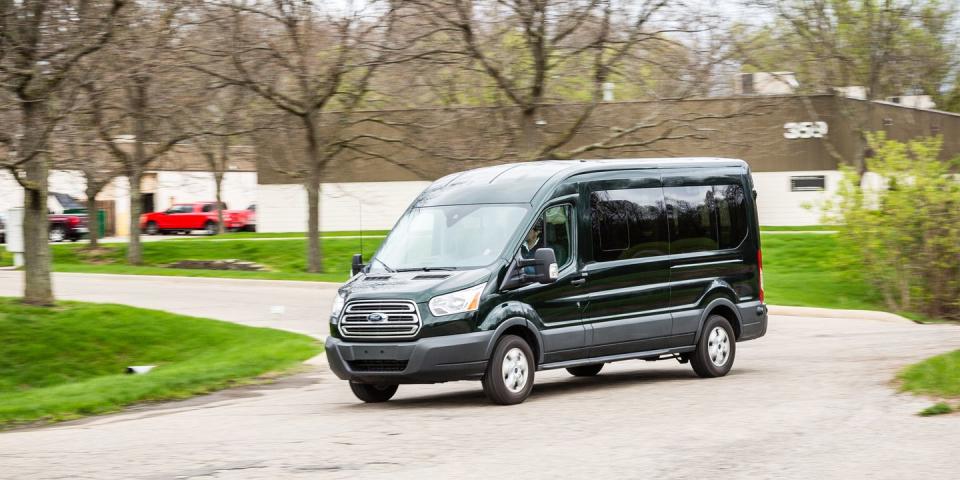
Ford owned the U.S. full-size-van business for decades with its E-series offerings and, as a consequence, was a bit behind some other manufacturers in offering Euro-style full-size boxes. Mercedes, Ram, and Nissan all were established players with the new type by the time Ford’s big Transits rolled onto the scene for the 2015 model year. But being a little late to the starting gate doesn’t seem to have diminished Ford’s robust van business-the company still leads the commercial-van sales race by a healthy margin-and the Transit seems to have been well worth the wait.
It’s offered in multiple sizes-two wheelbases and three roof heights-with three engine options, including a diesel. Ford offers single- and dual-wheel rear axles and the choice of either cargo (Van) or passenger (Passenger Wagon) versions; the latter is available in four seating configurations capable of accommodating between eight and 15 occupants.
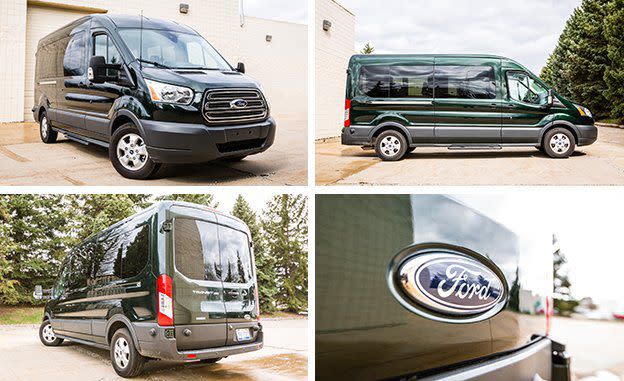
That would seem to cover the basic van market. The competition, by the way, includes no direct answer from General Motors, which still peddles the old-school Chevrolet Express/GMC Savana vans that were all-new in 1996.
A Dozen Seats
Our test unit was a mid-roof, long-wheelbase 350 Passenger Wagon XLT, meaning it was nearly six feet in interior height from the floor to the ceiling (if you need to transport basketball players, the high-roof version adds nine more inches). Who has a need for a van such as this? Pole-vault squads? Fly-fishing teams? Resorts, maybe, or church schools? Whatever its use case, there were seats for a dozen in our van, arranged in four rows-two up front, three in the second row, three in the third (two on the left with an aisle separating the right-hand seat), and four on a bench spanning the rear. The available 15-seat configuration adds another row of three seats and an industry-first five-row curtain airbag-but it has only 73 cubic feet of cargo space behind the rearmost seats (in mid-roof, long-wheelbase configuration) compared with the 94 cubic feet in the van we tested. Need more? There’s an optional extended-length body (high roof only) with 15 seats that boasts 100 cubic feet out back.
Although this van was kitted out with more than $7000 in optional equipment, the passenger accommodations were a little spartan. There are no USB ports aft of the front row, and cupholders and armrests are few and far between. On the other hand, each passenger seat provides enough room for a pretty good-size set of gluteal muscles, and of course there’s plenty of space in the vertical dimension.
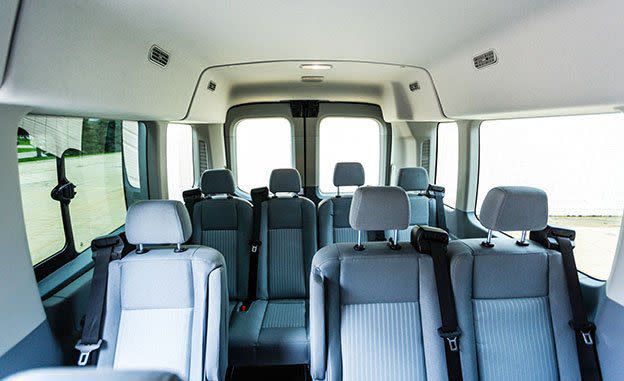
The passenger seats are accessed via a very large, single sliding door on the right side, and this particular van was equipped with a power running-board step ($940) that deployed when the sliding door was pulled opened.
Four Views
Up front a pair of relaxed-fit bucket seats look out over the sloping snout, affording excellent forward sightlines. Similarly, the base of the front windows slope down and provide a better-than-average view of what’s going on in the forward quarters, and the side windows in the wagon versions are generously sized, giving passengers a good look at passing scenery. No danger of claustrophobia here.
However, the driver’s view directly astern, minimized by rear-seat head restraints, is about the same as what you’d get in a buttoned-up Sherman tank-and that’s with an empty van. With passengers back there, what’s going on behind the van verges on mystery. The standard rearview camera in this vehicle is more than supplementary, it’s essential. That also goes for the exterior warning chime that activates when the driver engages reverse, a $125 option.
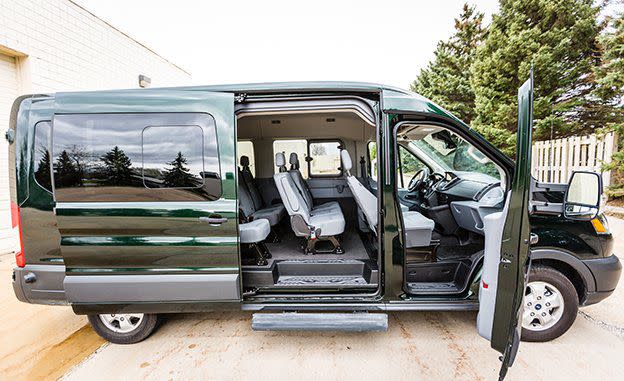
Selecting any gear in the six-speed automatic transmission is achieved with a shift lever mounted in the lower dashboard, just to the right of the steering wheel. There’s no sport mode-not at all surprising-but the shifter can be operated manually, via a thumb switch set into the top left side of the shifter; it’s not likely to see much use unless you’re a tour guide in some mountain park.
The Sprightly Mastodon
However, just putting it in drive and tramping on the throttle produces surprising results. Going from naught to 60 mph in 7.6 seconds with something this size-it weighs more than three tons, empty-is quite startling. (It was a bit more startling in the seriously empty cargo version we tested, which weighs 849 pounds less and hit 60 mph in 6.8 seconds.)
These track figures are achieved with only a driver aboard, of course, and we know the base 3.7-liter V-6 (275 horsepower, 260 lb-ft of torque) wouldn’t fare so well. But this van, like that cargo version, was equipped with the optional 3.5-liter EcoBoost mill, a turbocharged gasoline-fueled V-6 that huffs up more torque (400 lb-ft) than even the third available engine, a turbo-diesel 3.2-liter inline-five making 185 horsepower and 350 lb-ft that proved to be the segment’s diesel acceleration king in a three-van comparison test.
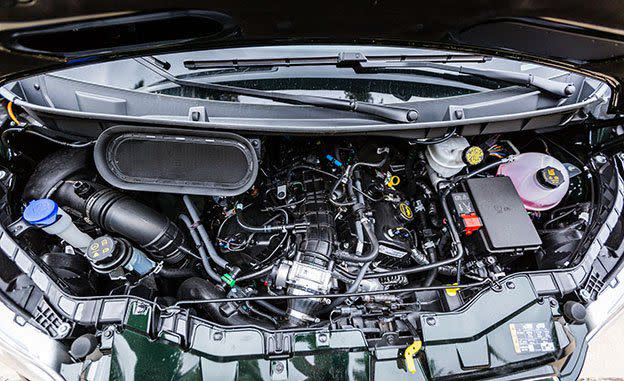
How might the Transit perform with its 12 seats full and enough baggage to challenge its 9000-pound GVWR (gross vehicle weight rating)? With our test Transit’s 6272-pound curb weight, a full load works out to 2728 pounds. A ton and a half of load would certainly mitigate the enthusiasm of the turbocharged V-6, but it’s fair to assume that a heavily laden Transit like this one could do better than hold its own in urban traffic.
Deliberate Dynamics
The rest of the Transit’s dynamic résumé isn’t so compelling. It turns and stops about as well as you’d expect of a vehicle with this much mass and an aspect ratio-the relationship of width to height-reminiscent of something powered by sails.
Achieving an indifferent 0.68 g on the skidpad was an adventure for the test driver, who reported massive understeer. With a center of gravity hovering somewhere close to the altitude of the driver’s backside and a compliant suspension, rock and roll is abundant. And it’s no surprise that a vehicle with 147.6 inches of wheelbase has a turning circle of almost 44 feet. It’s hard to say what, if anything, the optional ($325) limited-slip rear differential contributed to the van’s performance in dry conditions. Braking from 70 mph consumed nearly two-thirds of a football field, although there was no hint of fade in repeated stops.
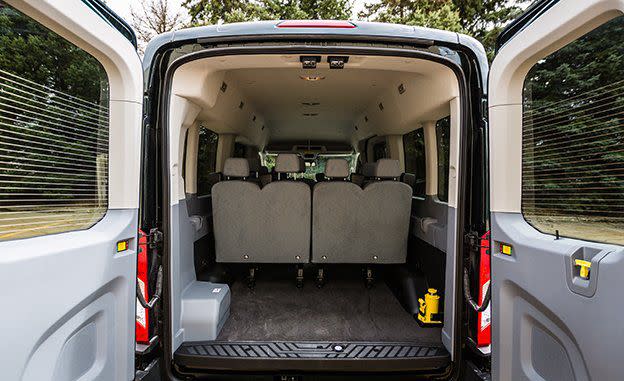
While you wouldn’t expect a vehicle of this size to be quick on its feet, another behavioral element can be unsettling. With its clipper-ship sail area, the Transit becomes unpleasantly active at freeway speeds, especially in a crosswind or in the wake of large semi trucks, a trait it shares with its competitors.
On the other hand, the Transit’s steering, while slow (3.5 turns lock-to-lock), is surprisingly accurate and even informative, particularly by the standards of this elephantine class. Ride quality is smooth, and interior noise levels are low, attributes that will certainly be appreciated by the folks in the back of the bus. As with heavy-duty trucks, the EPA doesn’t require fuel-economy ratings in this class. We logged 14 mpg overall, about the same as the Ram ProMaster but nowhere near the 22 mpg we recorded in a 2015 Transit with the same EcoBoost engine during a test with a much heavier bias toward highway travel.
As noted, this Transit had a number of options, none of them really associated with passenger comfort, unless you count the power-assist step. And maybe the privacy glass ($675 with an included rear-window defroster). Okay, a stretch: The 3.5-liter EcoBoost V-6 will probably get your curling team (or UnicornCon group, or baseball nine) to its destination a little quicker. To snag it, add $1865, the biggest-ticket item on our van’s bill.
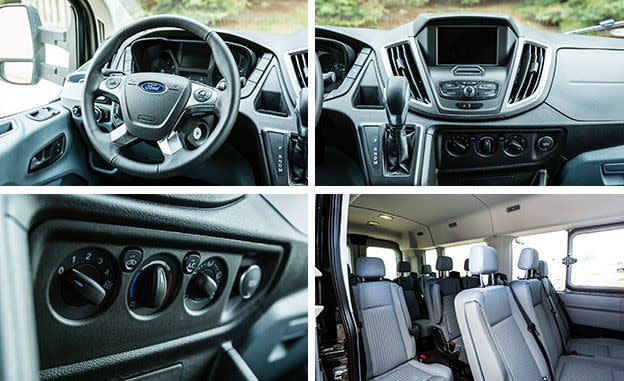
The second most expensive item on the window sticker is Ford’s Sync 3 infotainment system with navigation, a $1595 addition and probably a must in a van slated for urban delivery duty. All told, the extras added up to $7255, for a grand total of $49,220. That may seem a little stiff for a vehicle that is essentially utilitarian, but it’s in line with similarly equipped models from the competition, and fleets no doubt can receive a bulk discount.
The Ford Econoline and Club Wagon ruled the U.S. full-size-van biz for at least two generations-as in human generations. It looks as if the Transit era will sustain the family tradition.
('You Might Also Like',)

 Yahoo Autos
Yahoo Autos 